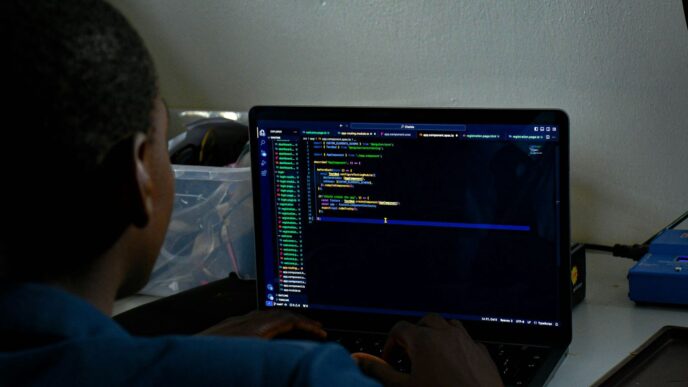The Ascendancy Of Artificial Intelligence In Software Testing
It’s pretty wild how much AI is changing things, and software testing is no exception. We’re seeing AI move from just a buzzword to something that’s actually making a difference in how we find bugs and make sure software works right. It’s not about replacing testers, but more about giving us super-powered tools.
AI-Driven Test Automation Advancements
Remember when test automation felt like a big, complicated project? Well, AI is making it smarter. Instead of just running pre-written scripts, AI can actually learn from how software behaves and even figure out what to test next. This means tests can adapt as the software changes, which happens a lot these days. It’s like having a testing assistant that gets better over time.
- Adaptive Test Execution: AI can adjust test cases on the fly based on code changes or previous test results. This stops us from running tests that are no longer relevant.
- Self-Healing Tests: When a test breaks because of a minor UI change, AI can sometimes fix the test script automatically, saving a lot of manual effort.
- Improved Test Coverage: AI can analyze code and identify areas that might be missed by traditional testing methods, helping us find those tricky, hidden bugs.
Predictive Analytics For Defect Identification
This is where things get really interesting. AI can look at all sorts of data – like past bug reports, code complexity, and even developer activity – to predict where new bugs are likely to pop up. This allows teams to focus their testing efforts on the riskiest parts of the application before problems even occur. It’s a big shift from just reacting to bugs after they’ve been found.
Here’s a quick look at how it works:
| Data Source | AI Analysis |
|---|---|
| Code Complexity | Identifies high-risk modules |
| Bug History | Predicts recurring defect patterns |
| Developer Commits | Flags areas with frequent changes |
| User Feedback | Highlights areas with reported issues |
Intelligent Test Case Generation
Writing test cases can be a real grind. AI is starting to help here too. By understanding the application’s requirements and user behavior, AI can actually generate new test cases. This isn’t just random generation; it’s about creating tests that are more likely to find real issues. It can also help in creating variations of existing tests, making sure we cover more scenarios without testers having to manually write every single one.
Embracing Continuous Quality Assurance
It feels like just yesterday we were talking about testing at the end of the development cycle. Now, the whole game has changed. We’re moving towards a model where quality isn’t just a final check, but something built in from the start and monitored constantly. This isn’t just about catching bugs earlier, though that’s a big plus. It’s about making sure the software works well in the real world, all the time.
Shift-Left Strategies For Early Defect Detection
Think of "shift-left" as moving testing activities as early as possible in the development process. Instead of waiting for a finished product, we’re getting developers and testers to work together from day one. This means things like static code analysis, unit testing, and even early integration testing happen way before the code is considered "done." The goal is simple: find and fix problems when they’re cheapest and easiest to deal with. It’s like catching a small leak before it floods the basement. We’re seeing more teams adopt practices that integrate testing directly into the development workflow, making it a natural part of building software, not an afterthought.
Shift-Right Methodologies For Production Monitoring
On the flip side, we have "shift-right." This is all about what happens after the software is out in the wild. We’re not just deploying and forgetting. Instead, we’re using tools to monitor how the application performs in the hands of actual users. This includes things like A/B testing, canary releases, and real-time performance monitoring. The idea is to gather feedback and data from the production environment to make quick adjustments and improvements. It’s about understanding user experience and system stability in real-time, allowing us to react to issues before they become widespread problems. This continuous feedback loop is key to maintaining high quality in a dynamic environment.
Quantifiable Quality Metrics For Performance Evaluation
To really know if we’re succeeding, we need numbers. Gone are the days of vague statements about quality. We’re now focused on specific, measurable metrics. This could include things like:
- Mean Time To Detect (MTTD): How quickly do we notice a problem in production?
- Mean Time To Resolve (MTTR): How fast can we fix it once we find it?
- Defect Density: The number of defects found per unit of code or functionality.
- Test Coverage: How much of the codebase is actually being tested?
- Application Performance Index (Apdex): A score that measures user satisfaction with application response times.
Having these kinds of metrics helps us track progress, identify areas needing improvement, and make data-driven decisions about our testing strategies. It turns quality from a feeling into a fact.
Navigating The Internet Of Things And Edge Computing
Okay, so the world is getting more connected, right? We’ve got all these smart devices talking to each other, and that’s where the Internet of Things (IoT) and edge computing come in. It’s pretty wild, but it also makes testing a whole lot trickier. We’re not just testing a single app on a computer anymore; we’re dealing with a whole network of gadgets, sensors, and processors, often working far from a central server.
Testing Complex IoT Ecosystems
Think about it: a smart home system involves a thermostat, lights, security cameras, maybe even a fridge, all communicating. Testing this means checking how they all play together. Does the thermostat correctly tell the lights to turn off when you leave? Does the security camera send alerts to your phone without a hitch? We need to look at the hardware, the software running on each device (firmware), and how they talk over different networks – Wi-Fi, Bluetooth, cellular. It’s a lot to keep track of. The real challenge is simulating all the possible ways these devices can interact and fail.
- Device Interoperability: Making sure devices from different manufacturers can actually talk to each other. This isn’t always straightforward.
- Network Variability: Testing how the system behaves with weak Wi-Fi, dropped connections, or even when devices are offline.
- Data Flow Integrity: Verifying that data collected by sensors gets to where it needs to go accurately and securely.
Simulating Real-World Edge Scenarios
Edge computing means processing data closer to where it’s generated, like on a factory floor or in a self-driving car. This cuts down on delays, which is great for things that need quick responses. But for testers, it means we need to mimic these on-site conditions. We can’t always rely on a perfect internet connection or a powerful data center. We have to test how these edge devices perform when resources are limited or when network conditions are less than ideal. It’s about making sure they’re reliable even when they’re out in the field, doing their own thing.
Ensuring Reliability In Connected Devices
Ultimately, people expect these connected devices to just work. If your smart lock doesn’t unlock or your medical sensor gives wrong readings, that’s a big problem. We need to test for security vulnerabilities, of course, but also for sheer dependability. How long can a device run on battery? What happens if it gets overloaded with data? We’re looking at performance under stress, how well it recovers from errors, and if it’s safe to use. It’s about building trust in these increasingly complex systems that are becoming a part of our everyday lives.
The Rise Of Ethical And Responsible Testing
It’s not just about finding bugs anymore, is it? As software gets more woven into our lives, especially with AI making decisions, we’ve got to think about the bigger picture. This means making sure the software we test isn’t just functional, but also fair and honest.
Addressing Algorithmic Fairness In AI Systems
AI is everywhere, and it’s making choices that affect people. Think about loan applications or even job candidate screening. If the AI is trained on biased data, it can end up making unfair decisions. Our job as testers is to look for these kinds of problems. We need to check if the AI’s outputs are consistent and don’t unfairly disadvantage certain groups. It’s about digging into the data used to train these systems and looking at how the algorithms actually work.
Ensuring Transparency And Accountability
When something goes wrong with an AI system, who’s responsible? It can be really hard to figure out. That’s where transparency comes in. We need to be able to understand why an AI made a certain decision. This means testers need to work with developers to build systems that can explain their reasoning. It’s also about having clear processes in place so that if there’s a problem, we know who to talk to and how to fix it. This focus on explainability is becoming a big deal.
Integrating Ethical Standards Into Testing Practices
So, how do we actually do this? It means adding ethical checks into our regular testing routines. We can start by:
- Developing checklists: Create specific questions to ask about fairness, privacy, and potential misuse during testing.
- Training the team: Make sure everyone on the testing team understands ethical considerations and knows how to spot potential issues.
- Collaborating with stakeholders: Talk to product owners, developers, and even legal teams to get a clear picture of what ethical standards are expected.
- Documenting findings: Keep good records of any ethical concerns found, just like you would with any other bug.
Emerging Technologies Shaping Test Strategies
Things are moving fast, aren’t they? It feels like just yesterday we were talking about basic automation, and now we’re looking at tech that sounds like science fiction. For 2025, a few of these new technologies are really starting to make waves in how we test software. It’s not just about finding bugs anymore; it’s about testing entirely new kinds of systems.
Robotic Process Automation Testing
Robotic Process Automation, or RPA, is becoming a big deal for businesses wanting to automate repetitive tasks. Think of it like digital workers handling things like data entry or processing forms. But just because it’s automated doesn’t mean it’s bug-free. We need to test these RPA bots to make sure they’re doing what they’re supposed to, accurately and reliably. This means checking that the bots follow the right steps, handle errors gracefully, and don’t accidentally mess up important data. It’s a whole new area where testing is needed to keep things running smoothly.
Blockchain System Verification
Blockchain technology, famous for cryptocurrencies, is also showing up in supply chains, healthcare, and more. It’s all about secure, shared ledgers. Testing blockchain systems is tricky because they’re decentralized and often involve smart contracts – self-executing agreements. We have to verify that these contracts work as intended, that the data on the chain is correct and can’t be tampered with, and that the whole network is secure against attacks. It’s a complex puzzle, and traditional testing methods often don’t quite fit.
Quantum Computing Testing Challenges
Okay, this one is still pretty far out for most of us, but quantum computing is on the horizon. These computers work in a fundamentally different way, using quantum mechanics. This means the way we test software for them will be completely different too. We’re talking about testing quantum algorithms, which are based on probabilities and superposition. It’s a whole new ballgame that will require new tools, new approaches, and a lot of learning for testers. We’ll likely need to think more statistically and focus on error tolerance, as perfect results might be harder to guarantee in the same way we expect today.
Digital Transformation In Validation Processes
So, validation processes are really changing, aren’t they? It feels like we’re finally moving past just printing out forms and calling it a day. For years, many companies were stuck in what you could call a "paper-on-glass" approach. Basically, they’d use digital systems, but they’d just mimic old paper ways of doing things. This meant lots of manual work, validation taking ages, and honestly, more mistakes because the systems couldn’t really adapt.
Audit Readiness As A Top Priority
This whole "paper-on-glass" thing made getting ready for audits a real headache. You’d spend weeks digging through documents, trying to make sure everything lined up. But now, the focus is shifting. Companies are realizing that being ready for an audit shouldn’t be a last-minute scramble. It needs to be built into the everyday work. Think about it: if your systems are already organized and your data is easy to find, audits become way less stressful. It’s about making sure your validation process is always inspection-ready, not just when the auditors are coming.
Data-Centric Validation Models
This is where things get interesting. Instead of focusing on individual documents, the trend is to look at all the data together. Imagine having a central place where all your validation data lives. This makes it way easier to track things and prove you’re following all the rules, like ALCOA++ principles (which are all about making sure data is attributable, legible, contemporaneous, original, and accurate, plus any other additions). This is a big change from just having piles of PDFs. It means using structured data that systems can actually understand and work with. It’s a much smarter way to handle validation, and honestly, it just makes more sense.
Here’s a quick look at how different these models are:
| Aspect | Document-Centric | Data-Centric |
|---|---|---|
| Primary Artifact | PDF/Word Documents | Structured Data Objects |
| Change Management | Manual Version Control | Git-like Branching/Merging |
| Audit Readiness | Weeks of Preparation | Real-Time Dashboard Access |
| AI Compatibility | Limited (OCR-Dependent) | Native Integration |
| Cross-System Traceability | Manual Matrix Maintenance | Automated API-Driven Links |
Validation As Code Implementation
This is a newer idea, but it’s gaining traction. It’s like software development, but for validation. You write your validation requirements as code. This means you can automate a lot of the testing, especially when you update your systems. Plus, you get version control, similar to how software developers track changes. Every test result can be linked back to the specific code that ran it, which is great for audits. It makes the whole process more transparent and repeatable. It’s a big step towards making validation more efficient and reliable, moving away from manual processes that are prone to human error.
Wrapping It Up
So, looking ahead to 2025, it’s clear that software testing isn’t just about finding bugs anymore. Things are changing fast, with AI and new ways of working like DevOps really shaking things up. We’re seeing more focus on testing early and often, and making sure our tests are actually useful, not just busywork. Plus, with all these new gadgets and systems coming out, testing them properly is becoming a bigger deal. Staying on top of these shifts means we can build better, more reliable software. It’s a lot to keep up with, but it’s also pretty exciting to see where things are headed.














